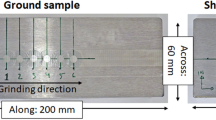Abstract
Aspects of machinability of Inconel 825 super alloy during electro-discharge machining was attempted in this work. The extent of machinability was investigated in purview of process performance (i.e. material removal rate), surface integrity (morphology as well as topography) of the EDMed work surface including surface roughness, surface crack density, white layer thickness, and micro-indentation hardness. Effects of variation of tool material (graphite, tungsten, brass and copper) were analyzed in this work. Metallurgical characteristics of the EDMed work surface were studied in view of phase information (matrix and precipitates), grain refinement (crystallite size, micro-strain and dislocation density) etc. Results were further interpreted in support of EDS, and micro-hardness test data. Additionally, effects of flushing condition (with and without flushing) of the dielectric medium were examined on influencing EDM performance on Inconel 825 work material. Moreover, effects of peak discharge current on EDM responses were discussed.
Similar content being viewed by others
References
Zeid OA (1997) On the effect of electro-discharge machining parameters on the fatigue life of AISI D6 tool steel. J Mater Process Technol 68(1):27–32
Aspinwall DK, Soo SL, Berrisford AE, Wälder G (2008) Workpiece surface roughness and integrity after WEDM of Ti6Al-4 V and Inconel 718 using minimum damage generator technology. CIRP Ann – Manuf Technol 57:187–190
Davim JP (2010) Surface integrity in machining. Springer, London
Thakur DG, Ramamoorthy B, Vijayaraghavan L (2012) Some investigations on high speed dry machining of aerospace material Inconel 718 using multicoated carbide inserts. Mater Manuf Process 27(10):1066–1072
Lee SH, Li XP (2001) Study of the effect of machining parameters on the machining characteristics in electrical discharge machining of tungsten carbide. J Mater Process Technol 115(3):344–358
Singh S, Maheshwari S, Pandey PC (2004) Some investigations into the electric discharge machining of hardened tool steel using different electrode materials. J Mater Process Technol 149(1):272–277
Hasçalk A, Çaydaş U (2007) Electrical discharge machining of titanium alloy (Ti–6A–4V). Appl Surf Sci 253(22):9007–9016
Muthuramalingam T, Mohan B (2013) Influence of tool electrode properties on machinability in spark erosion machining. Mater Manuf Process 28(8):939–943
Li L, Li ZY, Wei XT, Cheng X (2015) Machining characteristics of Inconel 718 by sinking-EDM and wire-EDM. Mater Manuf Process 30(8):968–973
D’Urso G, Maccarini G, Ravasio C (2016) Influence of electrode material in micro-EDM drilling of stainless steel and tungsten carbide. Int J Adv Manuf Technol 85(9-12):2013–2025
Jeswani ML (1981) Electrical discharge machining in distilled water. Wear 72(1):81–88
Chen SL, Yan BH, Huang FY (1999) Influence of kerosene and distilled water as dielectric on the electric discharge machining characteristics of Ti-6Al-4V. J Mater Process Technol 87(1):107–111
Yan BH, Tsai HC, Huang FY (2005) The effect in EDM of a dielectric of a urea solution in water on modifying the surface of titanium. Int J Mach Tools Manuf 45(2):194– 200
Zhang Y, Liu Y, Ji R, Cai B (2011) Study of the recast layer of a surface machined by sinking electrical discharge machining using water-in-oil emulsion as dielectric. Appl Surf Sci 257(14):5989–5997
Hewidy MS, El-Taweel TA, El-Safty MF (2005) Modelling the machining parameters of wire electrical discharge machining of Inconel 601 using RSM. J Mater Process Technol 169(2):328–336
Kuppan P, Rajadurai A, Narayanan S (2008) Influence of EDM process parameters in deep hole drilling of Inconel 718. Int J Adv Manuf Technol 38(1-2):74–84
Ahmad S, Lajis Ma (2013) Electrical discharge machining (EDM) of Inconel 718 by using copper electrode at higher peak current and pulse duration. IOP Conf Ser: Mater Sci Eng 012062:50. 10.1088/1757-899X/50/1/012062
Ay M, Çaydaş U., HasÇaık A (2013) Optimization of micro-EDM drilling of Inconel 718 superalloy. Int J Adv Manuf Technol 66(5-8):1015–1023
Rahul, Abhishek K, Datta S, Biswal BB, Mahapatra SS (2016) Machining performance optimization for electro-discharge machining of Inconel 601, 625, 718 and 825: an integrated optimization route combining satisfaction function, fuzzy inference system and Taguchi approach Journal of the Brazilian Society of Mechanical Sciences and Engineering
Rahul Datta S, Biswal BB, Mahapatra SS (2017) A novel satisfaction function and distance-based approach for machining performance optimization during electro-discharge machining on super alloy Inconel 718.Arabian Journal for Science and Engineering. https://doi.org/10.1007/s13369-017-2422-5
Bhattacharyya B, Gangopadhyay S, Sarkar BR (2007) Modelling and analysis of EDM ED job surface integrity. J Mater Process Technol 189(1):169–177
Choudhary R, Kumar H, Garg RK (2010) Analysis and evaluation of heat affected zones in electric discharge machining of EN-31 die steel. Int J Eng Mater Sci 17:91–98
Jahan MP, Wong YS, Rahman M (2009) A study on the fine-finish die-sinking micro-EDM of tungsten carbide using different electrode materials. J Mater Process Technol 209(8):3956–3967
Khan AA (2008) Electrode wear and material removal rate during EDM of aluminum and mild steel using copper and brass electrodes. Int J Adv Manuf Technol 39(5-6):482–487
Author information
Authors and Affiliations
Corresponding author
Appendices
Appendix I
APPENDIX II
APPENDIX III
Rights and permissions
About this article
Cite this article
Kumari, S., Datta, S., Masanta, M. et al. Electro-Discharge Machining of Inconel 825 Super alloy: Effects of Tool Material and Dielectric Flushing. Silicon 10, 2079–2099 (2018). https://doi.org/10.1007/s12633-017-9728-5
Received:
Accepted:
Published:
Issue Date:
DOI: https://doi.org/10.1007/s12633-017-9728-5







